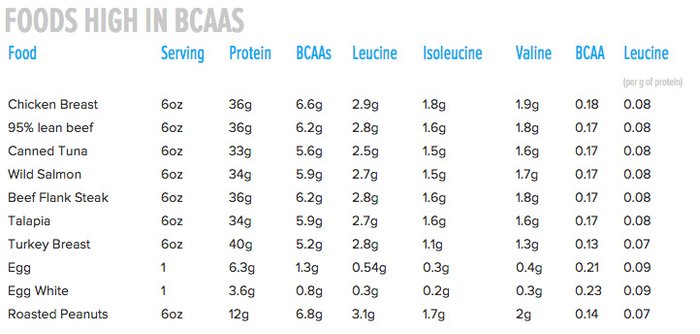Q: I like BCAA supplements, but I know that essential amino acids are also found in many foods. What are the best dietary sources of BCAAs?
Branched-chain amino acid supplements are extremely popular for boosting protein synthesis during and after training sessions, in addition to providing a convenient between-meal spike in the muscle-building amino acid leucine. However, with the explosion in popularity of BCAA supplementation, the role of dietary sources of these essential amino acids is often overlooked.
Chewing and swallowing your amino acids will never be as easy as simply mixing a powder in water. On the other hand, you can't live up to your full potential on supplements alone. Real foods offer a lot of valuable nutrition in addition to amino acids, so it's important to include them in your diet.
If you're looking to up your diet's potential to build muscle and aid recovery, check out this breakdown of the branched-chain amino acid content in some popular dietary protein sources:

This table reveals some interesting information about the branched-chain amino acids in foods. For example, turkey breast provides more total protein than any of the other proteins per ounce (not including eggs and egg whites, which aren't usually measured in ounces) but the smallest amount of total BCAAs. By comparison, a 6-ounce serving of dry-roasted peanuts packs more leucine and total BCAAs than any of the meat sources, but not nearly as much protein.
To minimize confusion and level the playing field a bit, I included the right two columns, which allow for better comparisons from one protein source to the next. Note that per gram of protein, eggs and egg whites provide the highest levels of branched-chain amino acids. Eggs are also marginally superior when it comes to leucine content. This should be of interest to you because leucine is the main driver of protein synthesis. That said, the amount of leucine is very similar per gram of total protein in all of the foods.
Which food is the best source of branched-chain amino acids?
Any of the foods listed above are good sources of branched-chain amino acids, as well as protein. The approximate amount of leucine needed at a given meal to maximize muscle protein synthesis is 3 grams, so 6 ounces of any of these meats is on the low side of what you would want to consume at a meal.
If you can stomach them, six whole eggs or nine egg whites would allow you to hit the 3-gram leucine target. On the other hand, 6 ounces of peanuts may not sound like a lot, but a handful is approximately 1 ounce, give or take, so 6 ounces is definitely a hefty portion.
The next step for you is to look closely at your diet (meal plan, calorie intake, and macro breakdowns) to see if you are consuming enough of these foods to get 3 grams of leucine per meal. If not, and you can't increase your servings of these protein foods due to calorie or macro restrictions, then consider upping your intake through BCAA supplementation.
How do BCAA supplements fit in?
Branched-chain amino acid drinks make it a lot easier to hit your amino acid requirements while keeping the rest of your diet under control. But, you should use them to fill the gaps or give you a little something extra for your workouts, not as a main source of amino acids. When you get leucine, valine, and isoleucine naturally from food, you're also getting other important nutrition your body needs like complete protein, healthy fats, and trace minerals.
Wrapping up
Eat a balanced diet with plenty of lean protein and vegetables, take BCAA supplements for your workouts, and you'll have plenty of amino acids on board to maximize your muscle gains.
Learn More
- Find out how much amino acid-packed protein to build into your diet with the protein calculator.
- Read about the benefits of branched-chain amino acids.
- Get more tips on how to build muscle.

